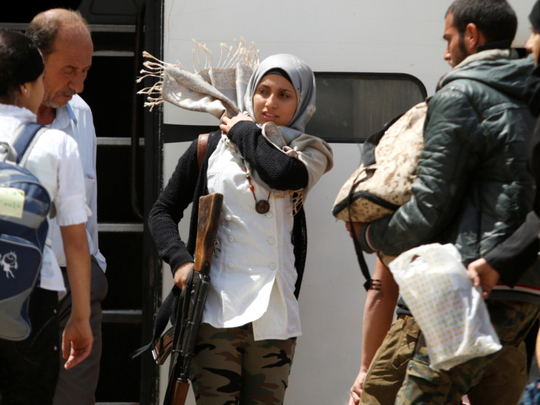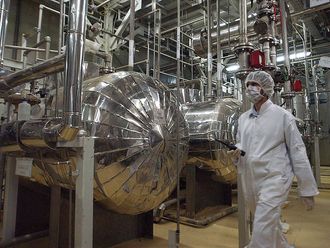
HOMS, Syria: Syrian rebels started leaving the last opposition-held district of Homs city on Saturday in the final phase of an evacuation deal that will see President Bashar Al Assad’s government take back the area in the seventh year of the country’s war.
At least one bus left Al Waer carrying fighters and their families, and dozens more were expected to follow to bring some 2,500 people out of the district long besieged by government forces and their allies.
The evacuation of Al Waer is one of the largest of its kind.
It follows a number of similar deals in recent months that have brought many parts of western Syria, long held by the opposition and besieged by government and allied forces, back under Al Assad’s control.
The deal, backed by Syria’s ally Russia, began to be implemented in March. Thousands of people have left in several stages. By the time it is completed, up to 20,000 people will have left the district, the British-based Syrian Observatory for Human Rights monitoring group says.
Many of the rebels are to head for insurgent-held Idlib province in Syria’s northwest and to the town of Jarablus along the country’s northern border with Turkey, pro-Damascus media reported. Some will stay in Al Waer and hand over their weapons as Syria’s military and its allies move in.
A Russian officer helping oversee the deal’s implementation told reporters Russian military police would help with the transition.
“Russia has a guarantor role in this agreement. Russian military police will stay, and will carry out duties inside the district,” Sergei Druzhin said through an Arabic interpreter.
Syria’s government calls the evacuation deals, which have also taken place in besieged areas around Damascus, and in Aleppo at the end of last year, reconciliation agreements. It says they allow services and security to be restored.
The opposition has criticised the agreements, however, saying they amount to forced displacement of Assad’s opponents away from Syria’s main urban centres, often after years of siege and bombardment.
Assad’s government, backed militarily since 2015 by Russia and since early on in the war by Iranian-backed militias, has negotiated the pacts from a position of strength and brought Syria’s major urban areas in the west back under its control.
Rebels still control some pockets of territory around Damascus and in the south, as well as almost all of Idlib province.
Daesh holds swathes of territory in the east of Syria, and is being fought by separate forces, including US-backed fighters and Russian-backed Syrian troops.











